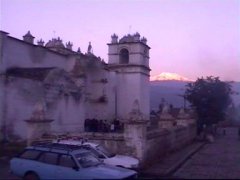 Continuation of "A TRANSLATION MEMOIR: 45 YEARS WITH CESAR VALLEJO"
Continuation of "A TRANSLATION MEMOIR: 45 YEARS WITH CESAR VALLEJO"Dr. Clayton Eshleman
At this point I contacted America Ferrari who was then teaching translation at a university in Geneva. He is the Vallejo scholar who had okayed my manuscript at Grove Press in the late 1960s. Ferrari had brought out an edition of Vallejo’s Cobra Poetical in 1988, and I figured he knew more about Vallejo’s poetry than anyone else. I asked him if he would respond my questions, and he agreed to. I would write him in English and he would respond in Spanish. He was willing to go to the library and research words he thought he was familiar with but when confronted by my questions became unsure. We had a wonderful exchange and around two years later, with sometimes up to thirty versions of the most complex poems, I had something that I thought was publishable. Marsalis brought out a bilingual edition of Trilce, with an Introduction by Ferrari, in 1992. They let it go out of print, and Wesleyan brought out a second edition, with around one hundred word changes, in 2000.
At that point, I felt that my involvement with Vallejo had come to an end. The only poetry of his that I had not translated was his first book, Los heralds engross (1918), which had always struck me as more conventional by far than Trilce or the European poetry. Much of it is rhymed verse and that presents, in translation, its own problems: a sonnet is a little engine of sound and sense, and if you rhyme it in translation, you will inevitably have to change some or much of it’s meaning. If you translate it for meaning alone, there is a good chance that you will end up with aphonic free verse.
But as Michael Carlene says midway through Godfather III, “just when you think you’re out, they pull you back in!” In 2003, I began to realize that all of the years I had put in on this body of work had brought me very close to “a complete poetry of Cesar Vallejo,” and that it would be appropriate to review all of my previous translating, and to add to it a version of Los heralds engross. Once I began to work on The Black Heralds, I found them more interesting than I had thought they were, and since they were relatively easy to render, I took some pleasure in what could be thought of as a level playing field rather than climbing a vertical wall. When I could rhyme certain words in a sonnet and not change the meaning, I did so, and I constantly made myself aware of sound possibilities, attempting to make the translations as sound rich in English as I could without distorting Vallejo’s intentions. Efrain Krista, a Latin American scholar at UCLA who has recently edited a Spanish edition of Los heralds engross, went over my third draft and made some very useful suggestions. I have also returned to the old title, Human Poems, for the European non-Spanish Civil War poems. Ethel University of California Press plans to bring out The Complete Poetry of Cesar Vallejo, with a Foreword by Mario Vargas Lola, in the fall of 2006. At the end of my Introduction to the 1968 Grove edition of Human Poems, I wrote “My work is done.” Assuming that Vallejo has not been writing away in his Montparnasse tomb, I now should be able to make such a statement stick.
| <<Page 6 | >>Page 8 | ||||||||||||||||||||||||||||||||||||||||||||||||||||||||||||||||||||||||||||||||||||||||||||||||||||||||||||||||||||||||||||||||||||||||||||||||||||||